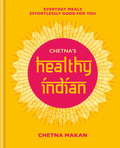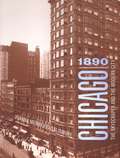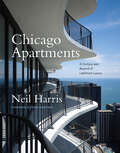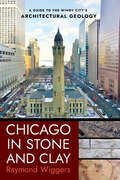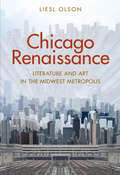- Table View
- List View
The Cherry Orchard (Modern Plays)
by Anton Chekhov Simon StephensThe funny thing is the harder I work the more clearly I understand things. When I'm worn out after a day's work then it's like my brain relaxes. And sometimes then I get it. The meaning of my life. My purpose on this earth. How many people ever get to say that? And you know what? It doesn't matter. Doesn't change anything. It is not important. In Chekhov's tragi-comedy - arguably his most popular play - the Gayev family is torn by powerful forces deeply rooted in history and the society in which they live. Their estate is hopelessly in debt. Urged to cut down their beautiful cherry orchard and sell the land for holiday cottages, the family struggles to act decisively. Vigorous and profound, this new version of Chekhov's classic play by Olivier award-winner Simon Stephens, from a literal translation by Helen Rappaport, is an anguished and heartbreaking love letter to a society in violent transition. It received its world premiere at the Young Vic, London, on 10 October 2014.
The Cherry Orchard: A Comedy In Four Acts (Modern Plays)
by Anton Chekhov Simon StephensThe funny thing is the harder I work the more clearly I understand things. When I'm worn out after a day's work then it's like my brain relaxes. And sometimes then I get it. The meaning of my life. My purpose on this earth. How many people ever get to say that? And you know what? It doesn't matter. Doesn't change anything. It is not important. In Chekhov's tragi-comedy - arguably his most popular play - the Gayev family is torn by powerful forces deeply rooted in history and the society in which they live. Their estate is hopelessly in debt. Urged to cut down their beautiful cherry orchard and sell the land for holiday cottages, the family struggles to act decisively. Vigorous and profound, this new version of Chekhov's classic play by Olivier award-winner Simon Stephens, from a literal translation by Helen Rappaport, is an anguished and heartbreaking love letter to a society in violent transition. It received its world premiere at the Young Vic, London, on 10 October 2014.
The Chester Cycle in Context, 1555-1575: Religion, Drama, and the Impact of Change (Studies in Performance and Early Modern Drama)
by Jessica Dell David KlausnerThe Chester Cycle in Context, 1555-1575 considers the implications of recent archival research which has profoundly changed our view of the continuation of performances of Chester's civic biblical play cycle into the reign of Elizabeth I. Scholars now view the decline and ultimate abandonment of civic religious drama as the result of a complex network of local pressures, heavily dependent upon individual civic and ecclesiastical authorities, rather than a result of a nation-wide policy of suppression, as had previously been assumed.
The Chester Cycle in Context, 1555-1575: Religion, Drama, and the Impact of Change (Studies in Performance and Early Modern Drama)
by Jessica Dell David KlausnerThe Chester Cycle in Context, 1555-1575 considers the implications of recent archival research which has profoundly changed our view of the continuation of performances of Chester's civic biblical play cycle into the reign of Elizabeth I. Scholars now view the decline and ultimate abandonment of civic religious drama as the result of a complex network of local pressures, heavily dependent upon individual civic and ecclesiastical authorities, rather than a result of a nation-wide policy of suppression, as had previously been assumed.
Chesterton and Tolkien as Theologians
by Alison MilbankThis book takes Chesterton's 'natural theology' through fairytales seriously as a theological project appropriate to an intellectual attempt to return to faith in a secular age. It argues that Tolkien's fiction makes sense also as the work of a Catholic writer steeped in Chestertonian ideas and sharing his literary-theological poetics. While much writing on religious fantasy moves quickly to talk about wonder, Milbank shows that this has to be hard won and that Chesterton is more akin to the modernist writers of the early twentieth-century who felt quite dislocated from the past. His favoured tropes of paradox, defamiliarization and the grotesque have much in common with writers like T. S. Eliot, Ezra Pound and James Joyce and their use of the demotic as well as the 'mythic method'. Using Chesterton's literary rhetoric as a frame, the book sets out to chart a redemptive poetics that first decentres the reader from his habitual perception of the world, then dramatizes his self-alienation through the grotesque, before finding in that very alienation a sort of pharmakon through paradox and an embrace of difference. The next step is to change one's vision of the world beyond the self through magic which, paradoxically, is the means by which one can reconnect with the physical world and remove the fetishism and commodification of the object. Chesterton's theology of gift is the means in which this magic becomes real and people and things enter into reciprocal relations that reconnect them with the divine.
Chetna's Healthy Indian: Everyday family meals effortlessly good for you
by Chetna MakanWe all know there is more to Indian food than just curries; it can also be really healthy, fresh and super delicious. Chetna's Healthy Indian contains home cooking at its best - straightforward methods, very few ingredients, crowd pleasing flavours, nourishment and comfort. It draws upon inspiration from Chetna's family and friends, creating realistic recipes for midweek, after work, busy weekends or when you simply want to look after yourself with wholesome food.You'll find 80 delicious recipes that require minimum time and effort, including Onion & whole spice chicken curry, Tandoori pan-fried sea bream, Paneer & cavalo nero saag and Baked cardamom & pistachio yogurt pots.Inspired by Indian cuisine, Chetna's Healthy Indian is proof that healthy food does not need to be health food, and convenient meals can be good for you, too.
The Chevalier Eon (SEB)
by RnibThis full length portrait shows Chevalier d'Eon, standing centrally facing the viewer with his head turned slightly to the left, dressed a fashionably good-looking woman of his time - a gown with an overskirt over a tiered skirt, low-cut bodice and three-quarter length ruffled sleeves. A dainty shoe can just be seen from beneath the tiered skirt. He has an elongated pearl earring is his left ear and he wears a cap over high-dressed hair. He also wears a Freemason's apron around his waist that shows the square and compass and has the order of St. Louis pinned on his left breast. His right hand rests on a sword that is held at his waist. His left arm is outstretched and he holds a long cane that is attached to his wrist by strings. To the right of Chevalier, immediately in front of his long cane, is a military coat hung over the back of a chair. Two chair legs can just be seen beneath the coat. To the left of Chevalier, is a table covered with a cloth hanging in heavy folds. The tip of his sword touches the edge of the table. On the table, nearest Chevalier, a scroll document, “A Policy 25 P Ct On the Chr D'Eon Man, or Woman,” hangs open over the table's cloth. Next to this document are two identical leather bound books, “Lettres du Chr D'Econ” and “L'Hist. du Chr D'Eon”, one on top of the other. Hanging on the wall immediately above Chevalier's head is a military hat and sword hand. Also hanging on the wall above both the table and the military coat on the chair are the bust of a man and a framed picture. The tactile image is slightly smaller than the actual image and shows the layout of the scene with some detail on Chevalier. Three textures show Chevalier's clothing - one for the tiered skirt and bodice, one for the overskirt and one for the apron. Solid texture shows the cap, sword, cane, Order of St. Louis, and one shoe showing beneath her dress. Lines show the ruffled sleeves and the hair under the cap. The bare skin has no texture. Solid texture also shows the frames around the two pictures, the hat and sword on the wall, the two busts, the bottom of the chair's legs and the shoe. The same texture for the overskirt also shows the military coat and the sketchy detail in the two framed pictures. The same texture for the apron also shows the cloth on the table. The same texture as the tiered skirt also shows the document on the table
Chic & Unique Flower Arrangements: Over 35 modern designs for simple floral table decorations (Chic & Unique)
by Julie Collins Tina ParkesMake your own stunning floral table centerpieces with this beautiful and practical guide to flower arranging from a team of award-winning master florists. Arrangements to suit every occasion including weddings, Christmas, vintage tea parties, mother's day, birthdays, family get-togethers and dinner parties, in a range of attractive styles and themes. Step-by-step advice on how to create each chic and unique design, with a helpful visual breakdown of the elements needed for each arrangement. An essential techniques section covers the basics of flower arranging giving you the floristry skills and confidence to make your own floral table decorations all year round.
Chic & Unique Flower Arrangements: Over 35 modern designs for simple floral table decorations (Chic & Unique)
by Julie Collins Tina ParkesMake your own stunning floral table centerpieces with this beautiful and practical guide to flower arranging from a team of award-winning master florists. Arrangements to suit every occasion including weddings, Christmas, vintage tea parties, mother's day, birthdays, family get-togethers and dinner parties, in a range of attractive styles and themes. Step-by-step advice on how to create each chic and unique design, with a helpful visual breakdown of the elements needed for each arrangement. An essential techniques section covers the basics of flower arranging giving you the floristry skills and confidence to make your own floral table decorations all year round.
Chicago 1890: The Skyscraper and the Modern City (Chicago Architecture and Urbanism)
by Joanna Merwood-SalisburyChicago’s first skyscrapers are famous for projecting the city’s modernity around the world. But what did they mean at home, to the Chicagoans who designed and built them, worked inside their walls, and gazed up at their façades? Answering this multifaceted question, Chicago 1890 reveals that early skyscrapers offered hotly debated solutions to the city’s toughest problems and, in the process, fostered an urban culture that spread across the country. An ambitious reinterpretation of the works of Louis Sullivan, Daniel Burnham, and John Wellborn Root, this volume uses their towering achievements as a lens through which to view late nineteenth-century urban history. Joanna Merwood-Salisbury sheds new light on many of Chicago’s defining events—including violent building trade strikes, the Haymarket bombing, the World’s Columbian Exposition, and Burnham’s Plan of Chicago—by situating the Masonic Temple, the Monadnock Building, and the Reliance Building at the center of the city’s cultural and political crosscurrents. While architects and property owners saw these pioneering structures as manifestations of a robust American identity, immigrant laborers and social reformers viewed them as symbols of capitalism’s inequity. Illuminated by rich material from the period’s popular press and professional journals, Merwood-Salisbury’s chronicle of this contentious history reveals that the skyscraper’s vaunted status was never as inevitable as today’s skylines suggest.
Chicago Apartments: A Century and Beyond of Lakefront Luxury
by Neil Harris Teri J. EdelsteinThe Chicago lakefront is one of America’s urban wonders. The ribbon of high-rise luxury apartment buildings along the Lake Michigan shore has few, if any, rivals nationwide for sustained architectural significance. This historic confluence of site, money, style, and development lies at the heart of the updated edition of Neil Harris's Chicago Apartments: A Century and Beyond of Lakefront Luxury. The book features more than one hundred buildings, stretching from south to north and across more than a century, each with its own special combination of design choice, floor plans, and background story. Harris, with the assistance of Teri J. Edelstein, proves to be an affable and knowledgeable tour guide, guiding us through dozens of buildings, detailing a host of inimitable development histories, design choices, floor plans, and more along the way. Of particular note are recent structures on the Chicago River and south of the Loop that are proposing new definitions of comfort and extravagance. Featuring nearly 350 stunning images and a foreword by renowned Chicago author Sara Paretsky, this new edition of Chicago Apartments offers a wide-ranging look inside some of the Windy City’s most magnificent abodes.
Chicago Apartments: A Century and Beyond of Lakefront Luxury
by Neil Harris Teri J. EdelsteinThe Chicago lakefront is one of America’s urban wonders. The ribbon of high-rise luxury apartment buildings along the Lake Michigan shore has few, if any, rivals nationwide for sustained architectural significance. This historic confluence of site, money, style, and development lies at the heart of the updated edition of Neil Harris's Chicago Apartments: A Century and Beyond of Lakefront Luxury. The book features more than one hundred buildings, stretching from south to north and across more than a century, each with its own special combination of design choice, floor plans, and background story. Harris, with the assistance of Teri J. Edelstein, proves to be an affable and knowledgeable tour guide, guiding us through dozens of buildings, detailing a host of inimitable development histories, design choices, floor plans, and more along the way. Of particular note are recent structures on the Chicago River and south of the Loop that are proposing new definitions of comfort and extravagance. Featuring nearly 350 stunning images and a foreword by renowned Chicago author Sara Paretsky, this new edition of Chicago Apartments offers a wide-ranging look inside some of the Windy City’s most magnificent abodes.
Chicago Apartments: A Century and Beyond of Lakefront Luxury
by Neil Harris Teri J. EdelsteinThe Chicago lakefront is one of America’s urban wonders. The ribbon of high-rise luxury apartment buildings along the Lake Michigan shore has few, if any, rivals nationwide for sustained architectural significance. This historic confluence of site, money, style, and development lies at the heart of the updated edition of Neil Harris's Chicago Apartments: A Century and Beyond of Lakefront Luxury. The book features more than one hundred buildings, stretching from south to north and across more than a century, each with its own special combination of design choice, floor plans, and background story. Harris, with the assistance of Teri J. Edelstein, proves to be an affable and knowledgeable tour guide, guiding us through dozens of buildings, detailing a host of inimitable development histories, design choices, floor plans, and more along the way. Of particular note are recent structures on the Chicago River and south of the Loop that are proposing new definitions of comfort and extravagance. Featuring nearly 350 stunning images and a foreword by renowned Chicago author Sara Paretsky, this new edition of Chicago Apartments offers a wide-ranging look inside some of the Windy City’s most magnificent abodes.
Chicago Apartments: A Century and Beyond of Lakefront Luxury
by Neil Harris Teri J. EdelsteinThe Chicago lakefront is one of America’s urban wonders. The ribbon of high-rise luxury apartment buildings along the Lake Michigan shore has few, if any, rivals nationwide for sustained architectural significance. This historic confluence of site, money, style, and development lies at the heart of the updated edition of Neil Harris's Chicago Apartments: A Century and Beyond of Lakefront Luxury. The book features more than one hundred buildings, stretching from south to north and across more than a century, each with its own special combination of design choice, floor plans, and background story. Harris, with the assistance of Teri J. Edelstein, proves to be an affable and knowledgeable tour guide, guiding us through dozens of buildings, detailing a host of inimitable development histories, design choices, floor plans, and more along the way. Of particular note are recent structures on the Chicago River and south of the Loop that are proposing new definitions of comfort and extravagance. Featuring nearly 350 stunning images and a foreword by renowned Chicago author Sara Paretsky, this new edition of Chicago Apartments offers a wide-ranging look inside some of the Windy City’s most magnificent abodes.
Chicago in Stone and Clay: A Guide to the Windy City's Architectural Geology
by Raymond WiggersChicago in Stone and Clay explores the interplay between the city's most architecturally significant sites, the materials they're made of, and the sediments and bedrock they are anchored in. This unique geologist's survey of Windy City neighborhoods demonstrates the fascinating and often surprising links between science, art, engineering, and urban history. Drawing on two decades of experience leading popular geology tours in Chicago, Raymond Wiggers crafted this book for readers ranging from the region's large community of amateur naturalists, "citizen scientists," and architecture buffs to geologists, architects, educators, and other professionals seeking a new perspective on the themes of architecture and urbanism. Unlike most geology and architecture books, Chicago in Stone and Clay is written in the informal, accessible style of a natural history tour guide, humanizing the science for the nonspecialist reader. Providing an exciting new angle on both architecture and natural history, Wiggers uses an integrative approach that incorporates multiple themes and perspectives to demonstrate how the urban environment presents us with a rich geologic and architectural legacy.
Chicago Makes Modern: How Creative Minds Changed Society
by Mary Jane Jacob Jacquelynn BaasChicago is a city dedicated to the modern—from the skyscrapers that punctuate its skyline to the spirited style that inflects many of its dwellings and institutions, from the New Bauhaus to Hull-House. Despite this, the city has long been overlooked as a locus for modernism in the arts, its rich tradition of architecture, design, and education disregarded. Still the modern in Chicago continues to thrive, as new generations of artists incorporate its legacy into fresh visions for the future. Chicago Makes Modern boldly remaps twentieth-century modernism from our new-century perspective by asking an imperative question: How did the modern mind—deeply reflective, yet simultaneously directed—help to dramatically alter our perspectives on the world and make it new? Returning the city to its rightful position at the heart of a multidimensional movement that changed the face of the twentieth century, Chicago Makes Modern applies the missions of a brilliant group of innovators to our own time. From the radical social and artistic perspectives implemented by Jane Addams, John Dewey, and Buckminster Fuller to the avant-garde designs of László Moholy-Nagy and Mies van der Rohe, the prodigious offerings of Chicago's modern minds left an indelible legacy for future generations. Staging the city as a laboratory for some of our most heralded cultural experiments, Chicago Makes Modern reimagines the modern as a space of self-realization and social progress—where individual visions triggered profound change. Featuring contributions from an acclaimed roster of contemporary artists, critics, and scholars, this book demonstrates how and why the Windy City continues to drive the modern world.
Chicago Makes Modern: How Creative Minds Changed Society
by Mary Jane Jacob Jacquelynn BaasChicago is a city dedicated to the modern—from the skyscrapers that punctuate its skyline to the spirited style that inflects many of its dwellings and institutions, from the New Bauhaus to Hull-House. Despite this, the city has long been overlooked as a locus for modernism in the arts, its rich tradition of architecture, design, and education disregarded. Still the modern in Chicago continues to thrive, as new generations of artists incorporate its legacy into fresh visions for the future. Chicago Makes Modern boldly remaps twentieth-century modernism from our new-century perspective by asking an imperative question: How did the modern mind—deeply reflective, yet simultaneously directed—help to dramatically alter our perspectives on the world and make it new? Returning the city to its rightful position at the heart of a multidimensional movement that changed the face of the twentieth century, Chicago Makes Modern applies the missions of a brilliant group of innovators to our own time. From the radical social and artistic perspectives implemented by Jane Addams, John Dewey, and Buckminster Fuller to the avant-garde designs of László Moholy-Nagy and Mies van der Rohe, the prodigious offerings of Chicago's modern minds left an indelible legacy for future generations. Staging the city as a laboratory for some of our most heralded cultural experiments, Chicago Makes Modern reimagines the modern as a space of self-realization and social progress—where individual visions triggered profound change. Featuring contributions from an acclaimed roster of contemporary artists, critics, and scholars, this book demonstrates how and why the Windy City continues to drive the modern world.
Chicago Renaissance: Literature and Art in the Midwest Metropolis
by Liesl OlsonA fascinating history of Chicago’s innovative and invaluable contributions to American literature and art from the late nineteenth to the mid-twentieth century This remarkable cultural history celebrates the great Midwestern city of Chicago for its centrality to the modernist movement. Author Liesl Olson traces Chicago’s cultural development from the 1893 World’s Fair through mid-century, illuminating how Chicago writers revolutionized literary forms during the first half of the twentieth century, a period of sweeping aesthetic transformations all over the world. From Harriet Monroe, Carl Sandburg, and Ernest Hemingway to Richard Wright and Gwendolyn Brooks, Olson’s enthralling study bridges the gap between two distinct and equally vital Chicago-based artistic “renaissance” moments: the primarily white renaissance of the early teens, and the creative ferment of Bronzeville. Stories of the famous and iconoclastic are interwoven with accounts of lesser-known yet influential figures in Chicago, many of whom were women. Olson argues for the importance of Chicago’s editors, bookstore owners, tastemakers, and ordinary citizens who helped nurture Chicago’s unique culture of artistic experimentation.Cover art by Lincoln Schatz
The Chicago School of Architecture: Building the Modern City, 1880–1910 (Shire Library USA #741)
by Rolf AchillesThe birth of the skyscraper in Chicago in the mid-1880s introduced a new direction for city architecture: upwards. But how-and why- was it that Chicago set the standard for high-rise buildings, not only across the USA but all over the world? Rolf Achilles here introduces the style of the First Chicago School from 1880 to 1910, explaining the innovative use of iron frames for strength, height and openness, and the ubiquity of gridded window arrangements. With reference to such famous architects as William Le Baron Jenny and Frank Lloyd Wright, and colorful pictures of, among many others, the Reliance, Brooks and Marquette buildings, this book is a fascinating exploration of the structures that helped to give Chicago its identity, and the world a new way of building.
The Chicago School of Architecture: Building the Modern City, 1880–1910 (Shire Library USA)
by Rolf AchillesThe birth of the skyscraper in Chicago in the mid-1880s introduced a new direction for city architecture: upwards. But how-and why- was it that Chicago set the standard for high-rise buildings, not only across the USA but all over the world? Rolf Achilles here introduces the style of the First Chicago School from 1880 to 1910, explaining the innovative use of iron frames for strength, height and openness, and the ubiquity of gridded window arrangements. With reference to such famous architects as William Le Baron Jenny and Frank Lloyd Wright, and colorful pictures of, among many others, the Reliance, Brooks and Marquette buildings, this book is a fascinating exploration of the structures that helped to give Chicago its identity, and the world a new way of building.
Chicago’s Bridges (Shire Library USA)
by Nathan HolthThe Chicago River divides America's Second City into the North and South Sides, and the bridges that span it are famous for their number and beauty. With the first constructed in 1832, it was only twelve years later that a moveable bridge appeared, and today Chicago is home to some sixty bridges in all, making it one of the most bridge-rich cities in the world. These bridges even today offer fascinating glimpses into Chicago's development from rough-and-tumble trading outpost to world-class city known for its architecture and culture, and this book traces the evolution of them all, from the original rising bascules to the splendidly designed twentieth-century structures that lend Chicago much of the grandeur for which it is known world-wide.
Chicago’s Bridges (Shire Library USA)
by Nathan HolthThe Chicago River divides America's Second City into the North and South Sides, and the bridges that span it are famous for their number and beauty. With the first constructed in 1832, it was only twelve years later that a moveable bridge appeared, and today Chicago is home to some sixty bridges in all, making it one of the most bridge-rich cities in the world. These bridges even today offer fascinating glimpses into Chicago's development from rough-and-tumble trading outpost to world-class city known for its architecture and culture, and this book traces the evolution of them all, from the original rising bascules to the splendidly designed twentieth-century structures that lend Chicago much of the grandeur for which it is known world-wide.
Chicago's Historic Hyde Park
by Susan O'Connor DavisStretching south from 47th Street to the Midway Plaisance and east from Washington Park to the lake’s shore, the historic neighborhood of Hyde Park—Kenwood covers nearly two square miles of Chicago’s south side. At one time a wealthy township outside of the city, this neighborhood has been home to Chicago’s elite for more than one hundred and fifty years, counting among its residents presidents and politicians, scholars, athletes, and fiery religious leaders. Known today for the grand mansions, stately row houses, and elegant apartments that these notables called home, Hyde Park—Kenwood is still one of Chicago’s most prominent locales. Physically shaped by the Columbian Exposition of 1893 and by the efforts of some of the greatest architects of the nineteenth and twentieth centuries—including Daniel Burnham, Frank Lloyd Wright, Mies Van Der Rohe—this area hosts some of the city’s most spectacular architecture amid lush green space. Tree-lined streets give way to the impressive neogothic buildings that mark the campus of the University of Chicago, and some of the Jazz Age’s swankiest high-rises offer spectacular views of the water and distant downtown skyline. In Chicago’s Historic Hyde Park, Susan O’Connor Davis offers readers a biography of this distinguished neighborhood, from house to home, and from architect to resident. Along the way, she weaves a fascinating tapestry, describing Hyde Park—Kenwood’s most celebrated structures from the time of Lincoln through the racial upheaval and destructive urban renewal of the 1940s, 50s, and 60s into the preservationist movement of the last thirty-five years. Coupled with hundreds of historical photographs, drawings, and current views, Davis recounts the life stories of these gorgeous buildings—and of the astounding talents that built them. This is architectural history at its best.
Chicago's Historic Hyde Park
by Susan O'Connor DavisStretching south from 47th Street to the Midway Plaisance and east from Washington Park to the lake’s shore, the historic neighborhood of Hyde Park—Kenwood covers nearly two square miles of Chicago’s south side. At one time a wealthy township outside of the city, this neighborhood has been home to Chicago’s elite for more than one hundred and fifty years, counting among its residents presidents and politicians, scholars, athletes, and fiery religious leaders. Known today for the grand mansions, stately row houses, and elegant apartments that these notables called home, Hyde Park—Kenwood is still one of Chicago’s most prominent locales. Physically shaped by the Columbian Exposition of 1893 and by the efforts of some of the greatest architects of the nineteenth and twentieth centuries—including Daniel Burnham, Frank Lloyd Wright, Mies Van Der Rohe—this area hosts some of the city’s most spectacular architecture amid lush green space. Tree-lined streets give way to the impressive neogothic buildings that mark the campus of the University of Chicago, and some of the Jazz Age’s swankiest high-rises offer spectacular views of the water and distant downtown skyline. In Chicago’s Historic Hyde Park, Susan O’Connor Davis offers readers a biography of this distinguished neighborhood, from house to home, and from architect to resident. Along the way, she weaves a fascinating tapestry, describing Hyde Park—Kenwood’s most celebrated structures from the time of Lincoln through the racial upheaval and destructive urban renewal of the 1940s, 50s, and 60s into the preservationist movement of the last thirty-five years. Coupled with hundreds of historical photographs, drawings, and current views, Davis recounts the life stories of these gorgeous buildings—and of the astounding talents that built them. This is architectural history at its best.
Chick Flicks: Contemporary Women at the Movies
by Suzanne Ferriss Mallory YoungFrom An Affair to Remember to Legally Blonde, "chick flicks" have long been both championed and vilified by women and men, scholars and popular audiences. Like other forms of "chick culture," which the editors define as a group of mostly American and British popular culture media forms focused primarily on twenty- to thirtysomething, middle-class—and frequently college-educated—women, chick flicks have been accused of reinscribing traditional attitudes and reactionary roles for women. On the other hand, they have been embraced as pleasurable and potentially liberating entertainments, assisting women in negotiating the challenges of contemporary life. A companion to the successful anthology Chick Lit: The New Woman’s Fiction, this edited volume consists of 11 original essays, prefaced by an introduction situating chick flicks within the larger context of chick culture as well as women’s cinema. The essays consider chick flicks from a variety of angles, touching on issues of film history, female sexuality (heterosexual and homosexual), femininity, female friendship, age, race, ethnicity, class, consumerism, spectatorship, pleasure and gender definition. An afterword by feminist film theorist Karen Hollinger considers the chick flick’s transformation from the woman’s films of the ’40s to the friendship films of the ’80s and those of the "return to the classics" trend of the ’90s, while highlighting the value of the volume’s contributions to contemporary debates and sketching possibilities for further study.



